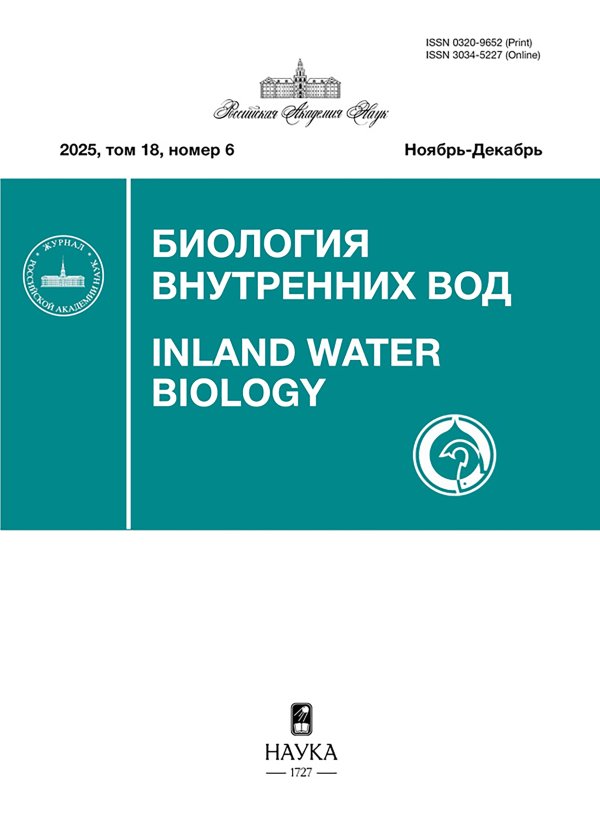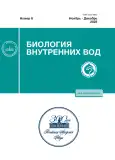Impact Algae Blooms on the Coastal Zone of the Curonian Lagoon of the Baltic Sea
- Authors: Aleksandrov S.V.1,2,3, Smirnova M.M.2
-
Affiliations:
- Atlantic Branch of the Russian Federal Research Institute of Fisheries and Oceanography
- Shirshov Institute of Oceanology Russian Academy of Sciences
- Immanuel Kant Baltic Federal University
- Issue: No 6 (2023)
- Pages: 801-810
- Section: ФИТОПЛАНКТОН, ФИТОБЕНТОС, ФИТОПЕРИФИТОН
- URL: https://journals.rcsi.science/0320-9652/article/view/232380
- DOI: https://doi.org/10.31857/S0320965223060037
- EDN: https://elibrary.ru/JVKAJD
- ID: 232380
Cite item
Full Text
Abstract
Lagoon ecosystem of the freshwater Curonian Lagoon belongs to hypertrophic water bodies, and its coastal zone is of fishery and recreational importance. Long-term monthly data (2014–2015) on chlorophyll and hydrochemical parameters were analyzed. The seasonal dynamics of chlorophyll a (phytoplankton abundance) in the whole Russian water area of the Curonian Lagoon and the influence on hydrochemical and microbiological indicators in the coastal zone near the Curonian Spit National Park (UNESCO World Heritage Site) were considered. During the period of intensive development of Cyanobacteria (“hyperblooming” of water), their acute accumulation in Russian water areas, estimated by chlorophyll, is determined by the wind regime, which causes the local accumulation in separate areas. Algae accumulation in the coastal zone (including the Curonian Spit National Park) in summer and autumn can form harmful hydrochemical and microbiological conditions, corresponding to hypertrophic and hypersaprobic levels, multiple excess of MPC (by BOD5 and ammonia nitrogen, anaerobic zone).
About the authors
S. V. Aleksandrov
Atlantic Branch of the Russian Federal Research Institute of Fisheries and Oceanography; Shirshov Institute of Oceanology Russian Academy of Sciences; Immanuel Kant Baltic Federal University; Immanuel Kant Baltic Federal University
Author for correspondence.
Email: hydrobio@mail.ru
Russia, Kaliningrad; Russia, Moscow; Russia, Kaliningrad; Russia, Kaliningrad
M. M. Smirnova
Shirshov Institute of Oceanology Russian Academy of Sciences
Email: hydrobio@mail.ru
Russia, Moscow
References
- Александров С.В. Влияние “цветения” синезеленых водорослей на экологическое состояние Куршского залива // Вода: химия и экология. 2009. № 4. С. 2.
- Александров С.В., Горбунова Ю.А. 2012. Продукция фитопланктона и содержание хлорофилла в эстуариях различного типа // Вестн. Балт. фед. ун-та им. И. Канта. № 1. С. 90.
- Александров С.В., Сенин Ю.М., Смыслов В.А. 2006. Первичная продукция, содержание хлорофилла и биогенных элементов как показатели экологического состояния Куршского и Вислинского заливов Балтийского моря // Биология внутр. вод. № 1. С. 41.
- Баринова Г.М. 1999. Климат // Калининградская область: очерки природы. Калининград: Янтар. сказка. С. 54.
- Бульон В.В. 1994. Закономерности первичной продукции в лимнических экосистемах. СПб.: Наука.
- Герб М.А., Полунина Ю.Ю., Ланге Е.К. и др. 2016. Характеристика биологических сообществ литорали западного побережья Куршского залива по данным гидробиологического мониторинга в 2015 году // Проблемы изучения и охраны природного и культурного наследия национального парка “Куршская коса”. Вып. 12. Калининград: БФУ им. И. Канта. С. 97.
- Герб М.А., Соколов А.А. 2011. Прибрежно-водная и береговая растительность Куршского залива в пределах национального парка “Куршская коса” // Проблемы изучения и охраны природного и культурного наследия национального парка “Куршская коса”: Сб. науч. статей. Калининград: БФУ им. И. Канта. С. 5.
- Кудрявцева Е.А., Александров С.В., Дмитриева О.А. 2018. Сезонная изменчивость первичной продукции и состава фитопланктона в береговой зоне российского сектора Гданьского бассейна Балтийского моря // Океанологические исследования. Т. 46. № 3. С. 99. https://doi.org/10.29006/1564-2291.JOR-2018.46(3).7
- Минкявичус А., Пипинис И. 1959. Обзор флоры и растительности залива Куршю Марес // Куршю Марес. Вильнюс: АН Лит. ССР. С. 109.
- Рыбные ресурсы Куршского залива: характеристика, рациональное использование, пути повышения продуктивности. 1985. Калининград: Кн. изд-во.
- Руководство по химическому анализу морских и пресных вод при экологическом мониторинге рыбохозяйственных водоемов и перспективных для промысла районов Мирового океана. 2003. М.: Изд-во ВНИИ рыб. хоз-ва и океаногр.
- Семенова А.С., Александров С.В. 2009. Потребление первичной продукции зоопланктоном и использование его структурно-функциональных характеристик для оценки трофности водоема // Биология внутр. вод. № 4. С. 57.https://doi.org/10.1134/S1995082909040099
- Сташко А.В., Александров С.В. 2023. Особенности пространственного распределения гидрохимических показателей в Куршском заливе Балтийского моря в 2018–2022 годах // Водные биоресурсы и среда обитания. Т. 6. № 1. С. 104. https://doi.org/10.47921/2619-1024-2023
- Трифонова И.С. 1990. Экология и сукцессия озерного фитопланктона. Л.: Наука.
- Цыбалева Г.А., Кузьмин С.Ю., Казимирченко О.В. 2016. Гидробиологическая и микробиологическая характеристика западной прибрежной зоны Куршского залива в 2014 году // Проблемы изучения и охраны природного и культурного наследия национального парка “Куршская коса”. Вып. 12. Калининград: БФУ им. И. Канта. С. 138.
- Червинскас Э. 1959. Основные черты гидрологического режима // Куршю Марес. Вильнюс: АН Лит. ССР. С. 47.
- Aleksandrov S., Krek A., Bubnova E. et al. 2018. Eutrophication and effects of algal bloom in the south-western part of the Curonian Lagoon alongside the Curonian spit // Baltica. V. 31. № 1. P. 1. https://doi.org/10.5200/baltica.2018.31.01
- Bartoli M., Zilius M., Bresciani M. et al. 2018. Drivers of Cyanobacterial Blooms in a Hypertrophic Lagoon // Frontiers Mar. Scie. V. 5. P. 434. https://doi.org/10.3389/fmars.2018.00434.
- Bresciani M., Adamo M., De Carolis G. et al. 2014. Monitoring blooms and surface accumulation of cyanobacteria in the Curonian Lagoon by combining MERIS and ASAR data // Remote Sensing Environ. V. 146. P. 124. https://doi.org/10.1016/j.rse.2013.07.040
- Bukaveckas P., Lesutiene J., Gasiunaite Z. et al. 2017. Microcystin in aquatic food webs of the Baltic and Chesapeake Bay regions // Estuarine, Coastal and Shelf Science. V. 191. P. 50. https://doi.org/10.1016/j.ecss.2017.04.016
- Cetkauskaite A., Zarkov D., Stoskus L. 2001. Water–quality control, monitoring and wastewater treatment in Lithuania 1950 to 1999 // Ambio. V. 30. № 4. P. 297. https://doi.org/10. 1579/0044-7447-30.4.297
- Dmitrieva O.A., Semenova A.S. 2011. Seasonal dynamics of phyto- and zooplankton and their interactions in the hypereutrophic reservoir // Inland Water Biol. V. 4. № 3. P. 308. https://doi.org/10.1134/S1995082911030059
- Ferrarin C., Razinkovas A., Gulbinskas S. et al. 2008. Hydraulic regime-based zonation scheme of the Curonian Lagoon // Hydrobiologia. V. 611. № 1. P. 133. https://doi.org/10.1007/s10750-008-9454-5
- Hakanson L., Boulion V.V. 2002. The like foodweb–modeling predation and abiotic/biotic interactions. Leiden: Backhuys Published.
- Jeffrey S.W., Humphrey G.F. 1975. New spectrophotometric equations for determining chlorophylls a, b, c1 and c2 in higher plants, algae and natural phytoplankton // Biochemie und Physiologie der Pflanzen. V. 167 (2). P. 191. https://doi.org/10.1016/S0015-3796(17)30778-3
- Kaziukonyte K., Lesutiene J., Gasiunaite Z. et al. 2021. Expert-based assessment and mapping of ecosystem services potential in the Nemunas Delta and Curonian Lagoon region, Lithuania // Water. V. 13. P. 2728. https://doi.org/10.3390/w13192728
- Olenina I. 1998. Long-term changes in the Kursiu Marios lagoon: Eutrophication and phytoplankton response // Ecologija. V. 1. P. 56.
- Overlingė D., Toruńska-Sitarz A., Kataržytė, M. et al. 2021. Characterization and diversity of microcystins produced by Cyanobacteria from the Curonian Lagoon (SE Baltic Sea) // Toxins. V. 13. P. 838. https://doi.org/10.3390/toxins13120838
- Paldaviciene A., Mazur–Marzec H., Razinkovas A. 2009. Toxic cyanobacteria blooms in the Lithuanian part of the Curonian Lagoon // Oceanologia. V. 51 (2). P. 203. https://doi.org/10. 5697/oc.51-2.203
- Pilkaitytë R., Razinkovas A. 2006. Factors controlling phytoplankton blooms in a temperate estuary: nutrient limitation and physical forcing // Hydrobiologia. V. 555. P. 41. https://doi.org/10.1007/s10750-005-1104-6
- Pilkaitytë R., Razinkovas A. 2007. Seasonal changes in phytoplankton composition and nutrient limitation in a shallow Baltic lagoon // Boreal Environ. Res. V. 12 (5). P. 551.
- Sulcius S., Pilkaitytë R., Mazur-Marzec H. 2015. Increased risk of exposure to microcystins in the scum of the filamentous cyanobacterium Aphanizomenon flos-aquae accumulated on the western shoreline of the Curonian Lagoon // Mar. Pollution Bulletin. V. 99. № 1–2. P. 264. https://doi.org//10.1016/j.marpolbul.2015.07.057
- Vybernaite-Lubiene I., Zilius M., Saltyte-Vaisiauske L. et al. 2018. Recent Trends (2012–2016) of N, Si, and P export from the Nemunas River Watershed: loads, unbalanced stoichiometry, and threats for downstream aquatic ecosystems // Water. V. 10. P. 1178. https://doi.org//10.3390/w10091178
Supplementary files














